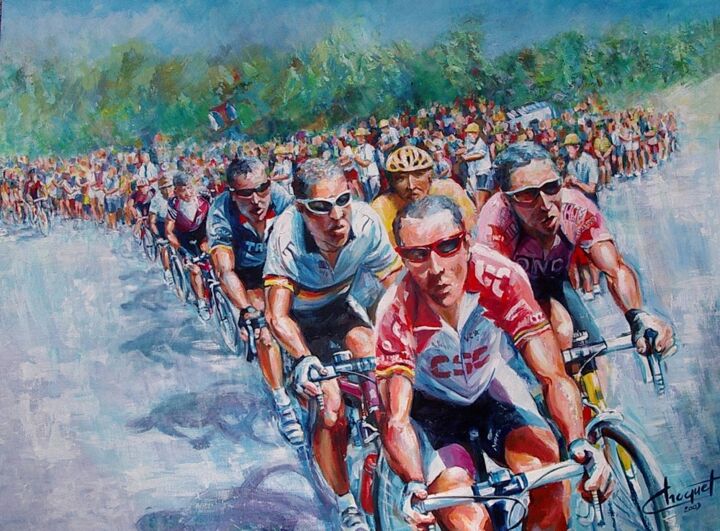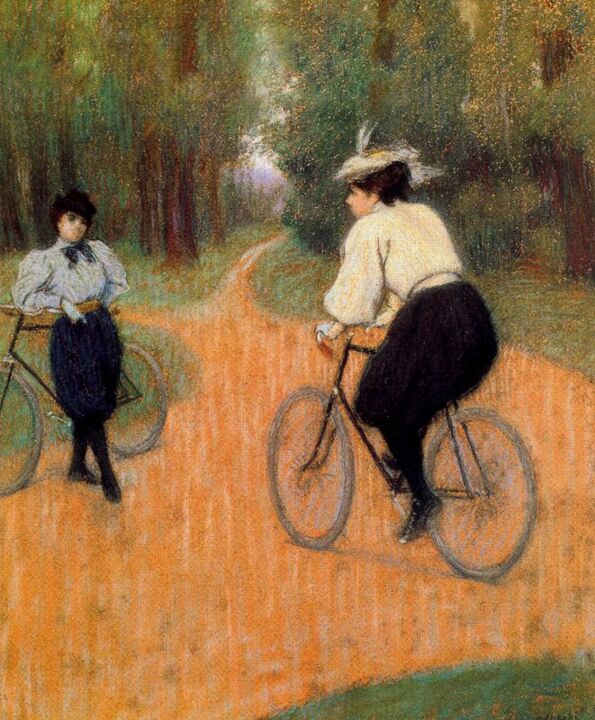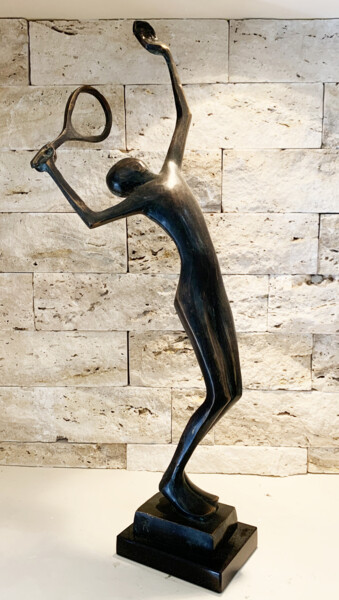The bicycle in art
The bicycle, despite the passage of time and the evolution of society, represents an evergreen means of locomotion, which has always attracted the interest of the greatest painters, sculptors, photographers and graphic designers in the history of Western art. The combination of art and bike has always generated high-level works, among which, it is impossible not to mention: Henri Toulouse-Lautrec's The Simpson Chain (1896), Natalia Goncharova's The Cyclist (1913), Salvator Dali's Sentimental Colloquy (1944), Fernand Léger's Leisure on a Red Background (1949) and Mario Schifano's Solo (1984). The aforementioned paintings or prints, although presenting particular and innovative stylistic elements, linked to precise artistic movements, have always immortalized people intent on pedaling, clearly distinguishing themselves from other products of artistic genius, which have depicted the bicycle in a less conventional way such as, for example, Marcel Duchamp's Bicycle Wheel (1913), Pablo Picasso's Bull's Head (1942), Jean Tinguely's Fragment from a Tribute to New York (1960), Christo and Jeanne-Claude's Wrapped bicycle on luggage rack (1962) and Gae Aulenti's Tour Table (1993).
Christo and Jeanne-Claude, Wrapped bicycle on luggage rack, 1962. Arlesheim: Forum Würth. @martin_ella
 Henri de Toulouse-Lautrec, The Simpson Chain, 1896. Color lithograph, poster, 828 x 1200 mm.
Henri de Toulouse-Lautrec, The Simpson Chain, 1896. Color lithograph, poster, 828 x 1200 mm.
Henri de Toulouse-Lautrec: The Simpson Chain
The work of the French master Toulouse-Lautrec is distinguished by the production of famous drawings and lithographs, which investigated with great interest the world of bicycles. As far as art graphics are concerned, among the works depicting the aforementioned topic, the already mentioned color lithograph of The Simpson Chain stands out strongly. It was conceived to illustrate the advertising campaign of the English company Simpson, a producer of bicycle chains. In fact, thanks to the French commercial agent, Louis Bouglé, the British company commissioned Toulouse-Lautrec to produce a poster to be used to promote its product in France. Consequently, in 1896, the great master produced two sketches, of which only the second, The Simpson Chain, was approved by the clients. The problem presented by the first draft was linked to the way in which the bicycle chain was represented, which, according to Mr. Simpson, had not been realized in sufficient detail and, therefore, valorized in its innovation. Returning instead to the successful lithograph, The Simpson Chain, which depicts the French champion Constant Huret riding a tandem, became the official advertisement of the product. Finally, most likely, the figures of the two bourgeois in the background of the print represent the two commissioners of the work, namely Mr Simpson and Louis Bouglé.
 Umberto Boccioni, Dynamism of a Cyclist, 1913. Oil on canvas, 70 x 95 cm. Venice: Peggy Guggenheim Collection.
Umberto Boccioni, Dynamism of a Cyclist, 1913. Oil on canvas, 70 x 95 cm. Venice: Peggy Guggenheim Collection.
Futurism and the bicycle
Futurism, a predominantly Italian artistic-literary avant-garde movement, was born with the intention of breaking with the patterns of the past, such as moderation, balance and the values of the well-thinking bourgeoisie. In this ideological context, the bicycle assumed an identification of national popular character, because, opposed to the lifestyle of the dominant castes, it represented courage, hard work and meritocracy. In addition, this means of locomotion also perfectly embodied the interest in dynamism, movement and speed, which distinguished the work of the Futurists. Therefore, the bicycle, and its great champions, inspired Futurist artists and poets, who saw physical activity as an integral part of human life, aimed at transmitting vital and creative energies. In fact, the exponents of this movement were characterized by a continuous and restless motion. The aforementioned ideology and interest in the bicycle took shape in many masterpieces of the genre, such as, for example, Umberto Boccioni's Dynamism of a Cyclist (1913), Gerardo Dottori's Cyclist (1914), Mario Sironi's The Cyclist (1916) and Fortunato Depero's Cyclists (1922).
 Jean Metzinger, At the Velodrome, 1912. Oil on canvas, 130.4 x 97.1 cm. Venice: Peggy Guggenheim Collection.
Jean Metzinger, At the Velodrome, 1912. Oil on canvas, 130.4 x 97.1 cm. Venice: Peggy Guggenheim Collection.
Lyonel Feininger, Bicycle Race, 1912. Oil on canvas. Washington: National Gallery of Art. @sport_in_art
 Choquet Christian, Tour de France annee 2003, 2003. Acrylic on fabric, 98 x 130 cm.
Choquet Christian, Tour de France annee 2003, 2003. Acrylic on fabric, 98 x 130 cm.
Choquet Christian: Tour de France annee 2003
The love of bicycles, dynamism and speed is also alive in contemporary art, as demonstrated by the acrylic color painting created by Artmajeur artist, Choquet Christian, and titled Tour de France annee 2003. In particular, the topic tackled by Choquet, that of the cycling competition, boasts illustrious precedents in the history of Western art, which have distinguished themselves among themselves by the type of perspective framing and the number of characters depicted. In fact, many important masters have immortalized this theme by painting a single racer, such as Jean Metzinger, who, in 1912, created At the Velodrome. Masterpieces marked instead by a crowded composition are those of Lyonel Feininger, Cycling Race (1912), and Aligi Sassu, Cyclists Uphill (1951). The painting by the artist from Artmajeur appears to be more akin, in terms of frontal perspective framing, to Jean Metzinger's canvas, while, regarding the style of the work, Tour de France annee 2003 represents almost a modern interpretation of Aligi Sassu's "realism." In spite of the above-mentioned affinities, Choquet's work differs from its antecedents, both for its very personal style of realization and for the way in which the crowd of spectators is depicted, which, referring to contemporary cycling events, has been realized on the same level as the riders, with whom, at times, it is confused. Therefore, Tour de France annee 2003 has been able to depict a topical classic of art history, mixing different influences and adding details with a strong contemporary flavor, which have generated a unique work of art.
 Federico Zandomeneghi, Meeting on a bicycle, 1896. Pastel, 40 x 32 cm. Milan: Enrico Piceni Foundation.
Federico Zandomeneghi, Meeting on a bicycle, 1896. Pastel, 40 x 32 cm. Milan: Enrico Piceni Foundation.
 David Gerstein: Città su ruote, 2016. Scultura in alluminio, 116 x 120 cm.
David Gerstein: Città su ruote, 2016. Scultura in alluminio, 116 x 120 cm.
David Gerstein: City on wheels
The bicycle has not only been depicted in the contexts of races and competitions, but also in its most varied uses in everyday life, such as moves, walking, and meeting, which have been perfectly rendered in the paintings by Federico Zandomeneghi, Encounter on a Bicycle (1896), by Ramón Casas, Ramón Casas and Pere Romeu on the Tandem (1897), by Andrew Wyeth, Young America (1950) and by Bo Bartlett, The Day Everything Changed Forever (2016). On the other hand, as far as the world of sculpture and installations is concerned, the aforementioned Wrapped bicycle on luggage rack by Christo and Jeanne-Claude (1962) and Maurizio Cattelan's Dynamo Secession (1997) provide us with further insight into the use of the aforementioned means of transportation in everyday life. The sculpture of the well-known artist of Artmajeur, David Gerstein, seems to want to complete the intent of the above-mentioned art, immortalizing, in a totally innovative, personal and accurate way, different types of people, who, "elected" as representatives of contemporary society show us the current mode of use of this means of transport. In fact, this unique work, dynamic and rich in details of our time, seems almost to represent a snapshot of all types of people, each distinguished by special features, you can meet in our cities.
Robert Rauschenberg, Riding bikes, 1998. Installation. Berlin: Fontaneplatz. @ellypirelly
 Gilbert Liblin, Bicyclette de Gisèle, 2007. Metal sculpture, 31 x 53 x 1 cm.
Gilbert Liblin, Bicyclette de Gisèle, 2007. Metal sculpture, 31 x 53 x 1 cm.
Gilbert Liblin: Bicyclette de Gisèle
The work of Artmajeur artist Gilbert Liblin represents yet another mode of representation of the bicycle in art, in which the means of locomotion is immortalized alone, in a timeless context, as in a sort of celebratory work. Well-known examples of what has just been described exist both in painting, as evidenced by Mario Schifano's Bicycle (1979), and in sculpture, as suggested by Robert Rauschenber's Riding bikes (1998). Within this context, however, Liblin's work appears in all its uniqueness, conferred by the shine of its metal, which makes the sculpture unique and almost precious, as if the artist had wanted to ennoble this popular means of transport, but incredibly useful and irreplaceable over time.


 Olimpia Gaia Martinelli
Olimpia Gaia Martinelli























